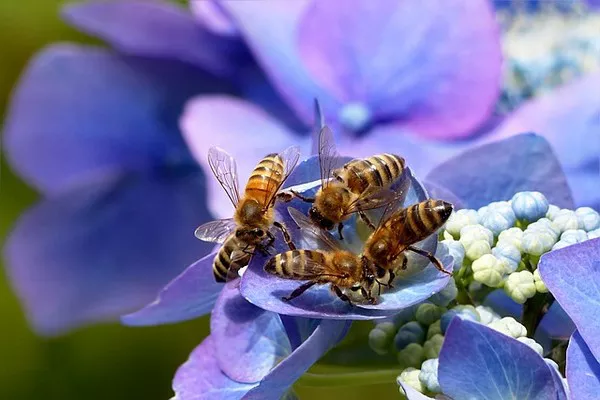Bees are nature’s unsung heroes, playing a pivotal role in pollinating plants and ensuring the reproduction of numerous crops and wildflowers. Their importance to the ecosystem and agriculture cannot be overstated. However, not all flowers are equally attractive to these industrious insects. Bees have their own preferences when it comes to nectar and pollen sources. In this article, we will delve into the world of bees and explore some of their favorite flowers.
Understanding Bee Preferences
Bees are incredibly discerning when it comes to selecting flowers. Their preferences are not arbitrary; instead, they are finely tuned by millions of years of evolution. Bees primarily rely on flowers for two essential resources: nectar and pollen. Nectar is a sugary liquid that serves as their primary source of energy, while pollen provides the protein necessary for bee larvae development.
Bees have evolved specific mechanisms to identify and access these resources efficiently. They are attracted to certain flower traits that indicate a reliable and rewarding source of nectar and pollen. Understanding these preferences can help gardeners, conservationists, and farmers design landscapes that support bee populations.
Color Preferences
One of the key factors that influence bee flower choices is color. Bees have excellent color vision, with a particular affinity for flowers that are blue, purple, and yellow. These colors stand out prominently against the green foliage of many plants, making them more easily visible to bees.
Blue and purple flowers are often favored by bumblebees and honeybees. Lavender, salvia, and blueberries are examples of plants with blue or purple blossoms that attract bees. On the other hand, yellow flowers are a favorite among many bee species, including the common honeybee. Sunflowers, daisies, and dandelions are popular choices.
Shape and Accessibility
The shape of a flower also influences its attractiveness to bees. Bees are adapted to feed from tubular flowers with easy access to nectar and pollen. These flowers provide a landing platform and a clear path to the resources they seek. Examples of such flowers include foxgloves, penstemons, and snapdragons.
Additionally, flowers with composite heads, like those of asters and daisies, are particularly appealing to bees. These flower structures offer multiple individual florets, each with its nectar and pollen, maximizing the reward for the bee’s effort.
Fragrance Matters
The scent of a flower is another important factor in attracting bees. Many flowers emit fragrances that are irresistible to these pollinators. These scents often contain chemical compounds that signal the presence of nectar and pollen, guiding bees to the source.
For example, the aroma of jasmine, roses, and lavender is known to attract bees. These scents act as natural advertisements, signaling to bees that a rewarding resource is nearby. Additionally, some flowers change their fragrance intensity throughout the day, with the scent being most potent during peak bee activity hours.
Seasonal Availability
Bees’ flower preferences can also be influenced by the time of year. Different bee species are active during various seasons, and their preferred flowers may vary accordingly. Early spring bees, for instance, are drawn to flowers like crocuses and snowdrops, while late summer bees might favor asters and goldenrods.
It’s crucial for those interested in supporting bee populations to plant a variety of flowers that bloom at different times of the year. This ensures that bees have a continuous supply of food throughout their active seasons.
The Impact of Native Plants
Native plants hold a special place in the hearts of bees. These plants have co-evolved with local bee species, making them particularly well-suited for pollination. Native plants often offer a harmonious relationship with bees, providing precisely the right amount of nectar and pollen needed by local bee populations.
For instance, in North America, native bee species often prefer native wildflowers like milkweed, coneflowers, and bee balm. These plants are not only a source of nourishment for bees but also serve as host plants for butterfly larvae, further contributing to the ecosystem’s health.
Avoiding Pesticides
No matter how attractive a flower may be to bees, the use of pesticides can make it lethal to these important pollinators. Pesticides, including neonicotinoids, are a significant threat to bee populations worldwide. Gardeners and farmers must avoid using these chemicals in their gardens and fields to protect bee health.
Organic gardening practices and integrated pest management (IPM) techniques can help control pests without harming bees. Additionally, choosing bee-friendly alternatives to chemical pesticides can support both bee populations and crop yields.
Conclusion
Bees are vital to the health of ecosystems and agriculture, making it crucial to understand their flower preferences. By planting a variety of bee-friendly flowers with the right colors, shapes, and scents, and by avoiding harmful pesticides, we can create environments that support these essential pollinators.
Whether you’re a dedicated gardener, a conservationist, or a farmer, you can play a role in safeguarding bee populations. By embracing bee-friendly practices and prioritizing the cultivation of their favorite flowers, we can ensure that bees continue to thrive and contribute to the pollination of our world’s diverse flora. Bees’ favorite flowers are not just beautiful to behold; they are also essential for our survival and the health of our planet.


